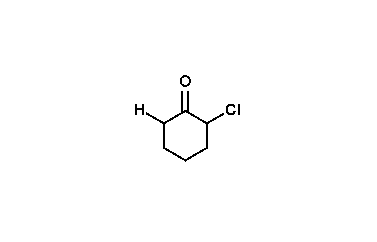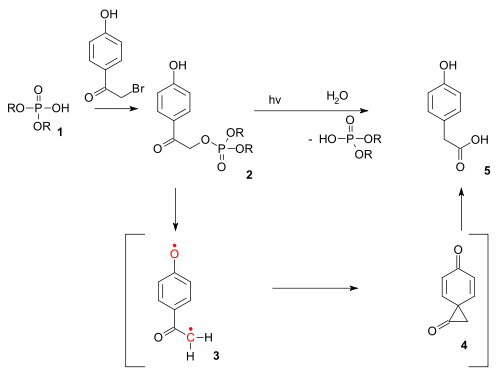Favorskii rearrangement
| Favorskii rearrangement | |
|---|---|
| Named after | Alexei Yevgrafovich Favorskii
|
| Reaction type | Rearrangement reaction |
| Identifiers | |
| Organic Chemistry Portal | favorsky-reaction |
| RSC ontology ID | RXNO:0000385 |
The Favorskii rearrangement is principally a rearrangement of

History
The reaction is named for the Russian chemist
Reaction mechanism
The reaction mechanism is thought to involve the formation of an enolate on the side of the ketone away from the chlorine atom. This enolate cyclizes to a cyclopropanone intermediate which is then attacked by the hydroxide nucleophile. Its formation can otherwise be viewed as a 2-electron electrocyclization of a 1,3-dipole, which can be captured in Diels Alder reactions. The cyclopropanone intermediate is opened to yield the more stable carbanion, which is quickly protonated.[9]

The second step has also been proposed to be stepwise process, with chloride anion leaving first to produce a zwitterionic oxyallyl cation before a disrotatory electrocyclic ring closure takes place to afford the cyclopropanone intermediate.[10]
Usage of alkoxide anions such as sodium methoxide, instead of sodium hydroxide, yields the ring-contracted ester product.
When enolate formation is impossible, the Favorskii rearrangement takes place by an alternate mechanism, in which addition to hydroxide to the ketone takes place, followed by concerted collapse of the tetrahedral intermediate and migration of the neighboring carbon with displacement of the halide. This is sometimes known as the pseudo-Favorskii rearrangement or quazi-Favorskii rearrangement, although previous to labeling studies, it was thought that all Favorskii rearrangements proceeded through this mechanism.

|
| An animation of the reaction mechanism |
Wallach degradation
In the related Wallach degradation (Otto Wallach, 1918) not one but two halogen atoms flank the ketone resulting in a new contracted ketone after oxidation and decarboxylation[11][12]
Photo-Favorskii reaction
The reaction type also exists as a
See also
- Trimethylenemethane cycloaddition, which can proceed via a similar mechanism
- Homo-Favorskii rearrangement, the rearrangement of β-halo ketones and cyclobutanones
- Wolff rearrangement - can react similarly
References
- )
- ; Collected Volumes, vol. 6, p. 368.
- .
- ; Collected Volumes, vol. 7, p. 135.
- ; Collected Volumes, vol. 4, p. 594.
- Favorskii, A. E. (1894). J. Russ. Phys. Chem. Soc. 26: 590.)
{{cite journal}}: CS1 maint: untitled periodical (link - Favorskii, A. E. (1905). J. Russ. Phys. Chem. Soc. 37: 643.)
{{cite journal}}: CS1 maint: untitled periodical (link - .
- ISBN 0-12-429785-4.)
{{cite book}}: CS1 maint: numeric names: authors list (link - ISSN 0036-021X.
- .
- .
- .
- PMID 18290649.
- ^ Eaton, Philip E.; Cole, Thomas W. (1964). "Cubane". J. Am. Chem. Soc. 86 (15): 3157–3158. doi:10.1021/ja01069a041.
Further reading
- Chenier, Philip J. (1978). "Favorskii rearrangement in bridged polycyclic compounds". Journal of Chemical Education. 55 (5): 286. .


